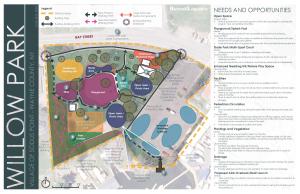The Importance of Park Master Planning: A Blueprint for Thriving Communities
The Foundation of Effective Planning
Park master planning is a critical process that shapes the future of our green spaces, ensuring they meet the needs of a community while offering long-term social, environmental, and economic benefits. A well-developed park master plan serves as a comprehensive blueprint that guides the creation, enhancement, and management of parks and recreational areas. This process involves collaboration among various stakeholders, including community members, landscape architects, community planners, and engineers, each bringing their expertise to craft spaces that truly resonate with and benefit their users.
 The success of any park master plan begins with robust community involvement. Engaging residents in the planning process is crucial for creating spaces that reflect local needs, preferences, and aspirations. Through interactive mapping, surveys, public meetings, and community workshops, our team gathers valuable input on what existing challenges and opportunities the space poses, and the features and amenities that are most desired by the community. This hands-on approach not only ensures that the park meets the needs of its users but also fosters a sense of ownership and pride among community members. When people are actively involved in the design process, they are more likely to use and care for the park, which contributes to its overall success and long-term sustainability.
The success of any park master plan begins with robust community involvement. Engaging residents in the planning process is crucial for creating spaces that reflect local needs, preferences, and aspirations. Through interactive mapping, surveys, public meetings, and community workshops, our team gathers valuable input on what existing challenges and opportunities the space poses, and the features and amenities that are most desired by the community. This hands-on approach not only ensures that the park meets the needs of its users but also fosters a sense of ownership and pride among community members. When people are actively involved in the design process, they are more likely to use and care for the park, which contributes to its overall success and long-term sustainability.
Landscape architects and community planners play an essential role in transforming community ideas into functional, aesthetically pleasing, and sustainable park designs. Their expertise in spatial design, environmental stewardship, and sustainability helps create spaces that are not only beautiful but also practical and resilient. They consider factors such as site topography, vegetation, and climate to design landscapes that enhance each user experience while preserving natural resources. From conceptualizing playgrounds and splash pads to designing multi-use trails and athletic facilities, landscape architects ensure that every element of the park contributes to a cohesive and inviting environment.
Our team works to ensure that parks are seamlessly integrated into the broader urban or suburban landscape, assessing how park developments align with existing zoning regulations, transportation networks, and comprehensive plans. By analyzing demographic trends, land use patterns, and accessibility, we can ensure that parks are strategically located and designed to serve diverse populations. Through community input and engagement strategies, we begin to understand the broader context in which a park exists, creating spaces that are well-connected and accessible and contributing to the overall livability and functionality of the area.
Landscape architects also bring their technical expertise to the park master planning process, focusing on the feasibility and safety of proposed designs. They address critical elements such as grading, drainage, and infrastructure to ensure that park features are both functional and durable. For instance, landscape architects practice climate resiliency by designing stormwater management systems to prevent flooding, implementing sustainable practices like green infrastructure, and incorporating universal design standards to create ADA-accessible pathways for park users of all ages and mobility types. By incorporating climate resiliency, green infrastructure, universal design, and habitat restoration, we assist communities in taking a progressive stance in addressing important issues, such as rising fuel prices, environmental degradation, and health problems related to inactivity.
The Benefits of a Well-Executed Park Master Plan
Social Benefits: A thoughtfully designed park master plan creates vibrant, inclusive spaces that foster community interaction and well-being. Parks become gathering places for social events, recreational activities, and cultural celebrations, enhancing community cohesion and quality of life. Accessible features and diverse amenities ensure that people of all ages and abilities can enjoy the park, promoting social equity and inclusion.
Environmental Benefits: Sustainable park master planning incorporates green infrastructure, native plantings, and habitat preservation, contributing to environmental stewardship. Parks can help mitigate urban heat islands, improve air and water quality, and provide vital green spaces for local wildlife. By integrating eco-friendly practices, parks support environmental health and resilience.
Economic Benefits: Investing in well-planned parks can drive economic growth by increasing property values, attracting businesses, and boosting local tourism. Parks enhance the appeal of neighborhoods, making them more attractive to potential residents and investors. Furthermore, parks reduce healthcare costs by promoting physical activity and mental well-being, resulting in long-term economic savings for communities.
Taking Action
 Our team’s involvement does not end once a master plan design has been completed! By having already analyzed the community’s concerns and priorities, and established conceptual plans for priority projects, communities will be well-positioned to move recommended projects forward to detailed design and construction. Our landscape architects and planners provide in-depth funding and implementation strategies and develop phasing plans for the recommended priority projects. Our strategies pair priority projects with accompanying action items, an estimated amount of time required to complete the project, a generalized scale of cost, and any group, agency, organization, or board that the community may desire to partner with to implement them. A phasing plan allows for the organized execution of improvements, ensuring that each element is installed effectively and efficiently. Our team encourages communities to advocate for additional studies, secure funding for implementation, raise public awareness and support, and consistently update the master plan document as requirements evolve to ensure success in the overall betterment of the community!
Our team’s involvement does not end once a master plan design has been completed! By having already analyzed the community’s concerns and priorities, and established conceptual plans for priority projects, communities will be well-positioned to move recommended projects forward to detailed design and construction. Our landscape architects and planners provide in-depth funding and implementation strategies and develop phasing plans for the recommended priority projects. Our strategies pair priority projects with accompanying action items, an estimated amount of time required to complete the project, a generalized scale of cost, and any group, agency, organization, or board that the community may desire to partner with to implement them. A phasing plan allows for the organized execution of improvements, ensuring that each element is installed effectively and efficiently. Our team encourages communities to advocate for additional studies, secure funding for implementation, raise public awareness and support, and consistently update the master plan document as requirements evolve to ensure success in the overall betterment of the community!
A Framework for Future Improvements
A park master plan is more than just a static document; it serves as a dynamic framework for future improvements and developments. As communities evolve and needs change, the master plan provides a strategic roadmap for ongoing enhancements. By setting clear goals and priorities, it guides the phased implementation of park features and ensures that investments are aligned with community needs and values.
In conclusion, park master planning is a vital process that involves the collective effort of community members, landscape architects, community planners, and engineers. By working together to create thoughtful, inclusive, and sustainable designs, we lay the foundation for parks that offer lasting social, environmental, and economic benefits. As we continue to develop and improve our public spaces, these master plans will ensure that our parks remain vibrant, resilient, and cherished assets for generations to come. For more information, reach out to Olivia Mallon or Emily DeWindt, our Landscape Architects.


